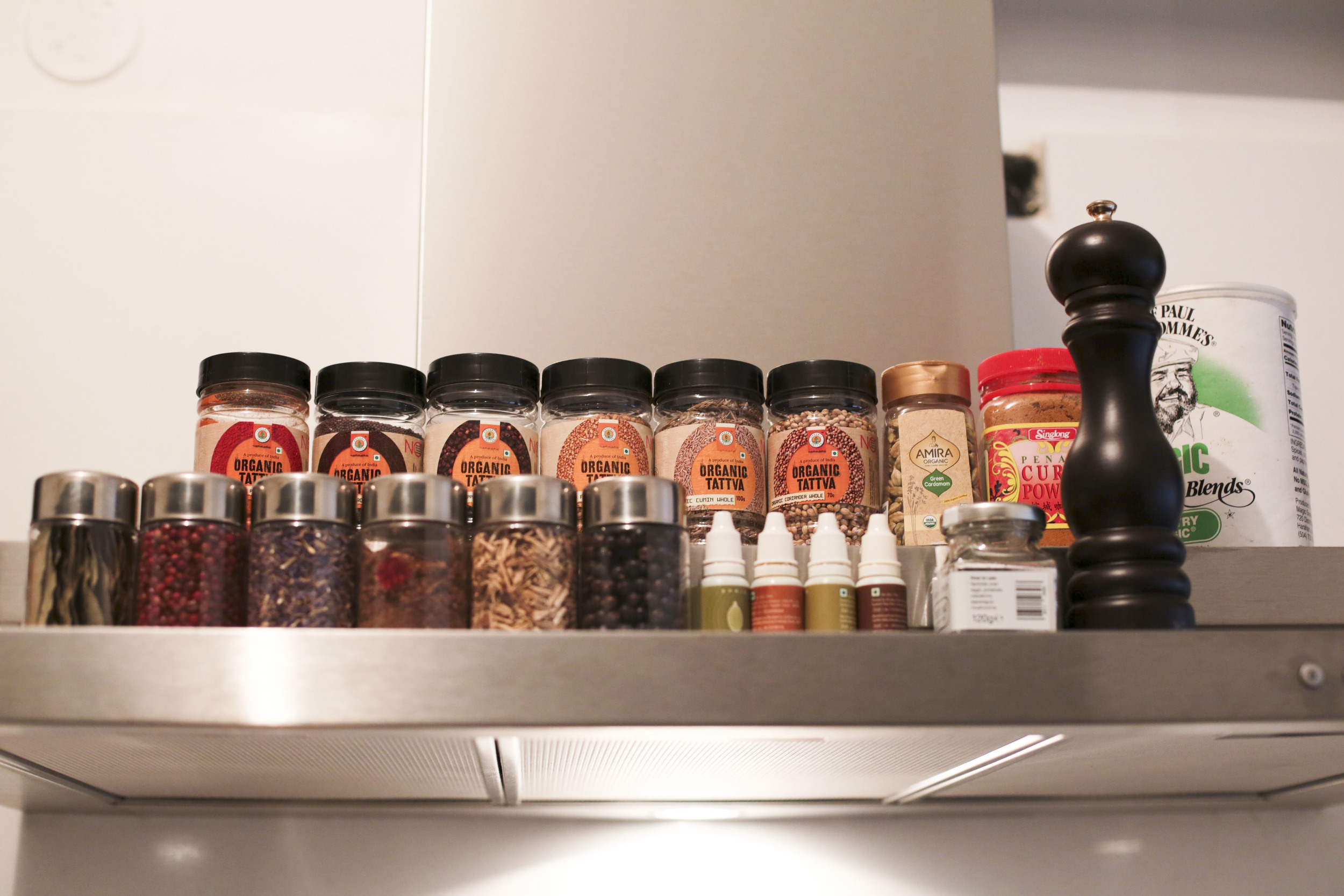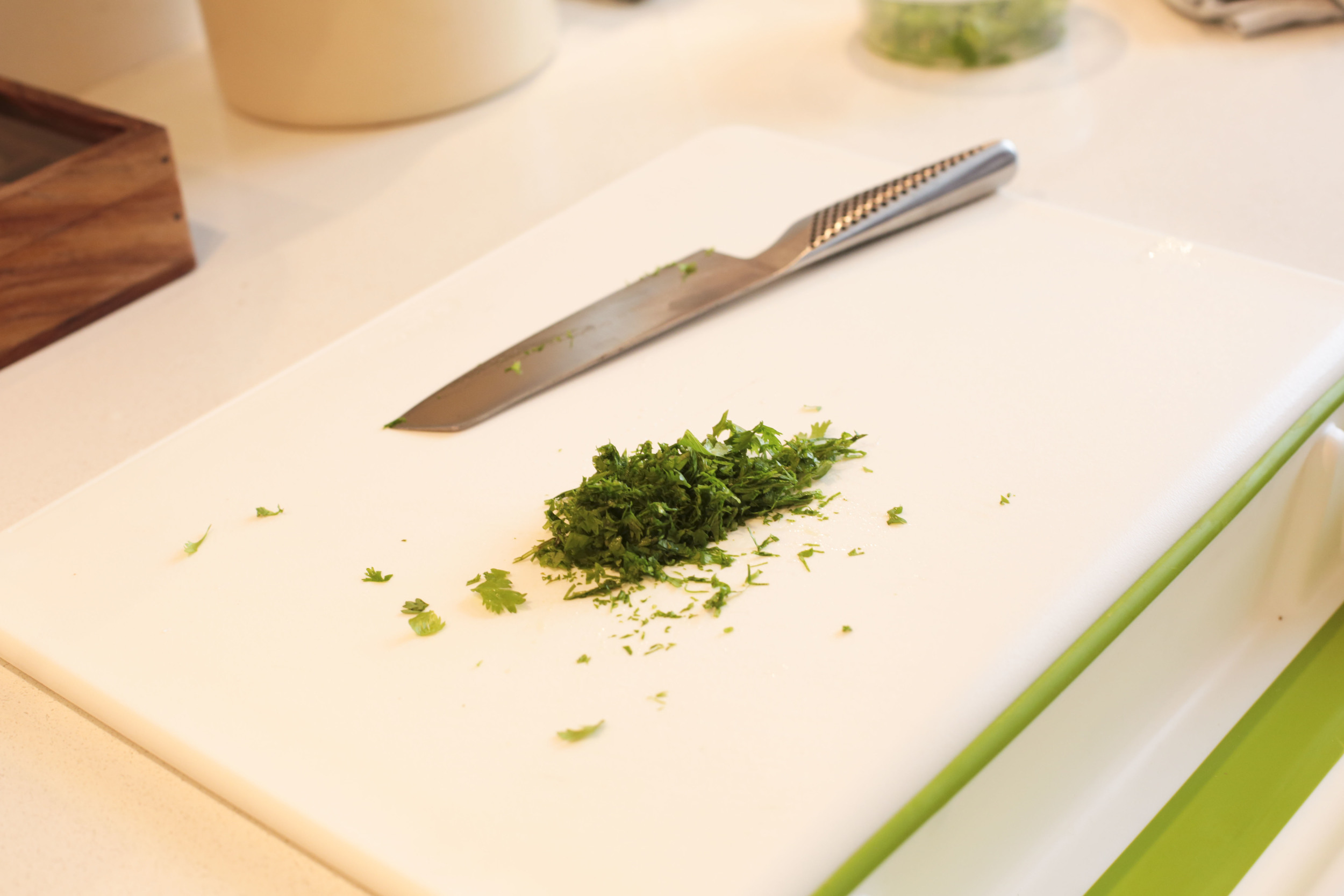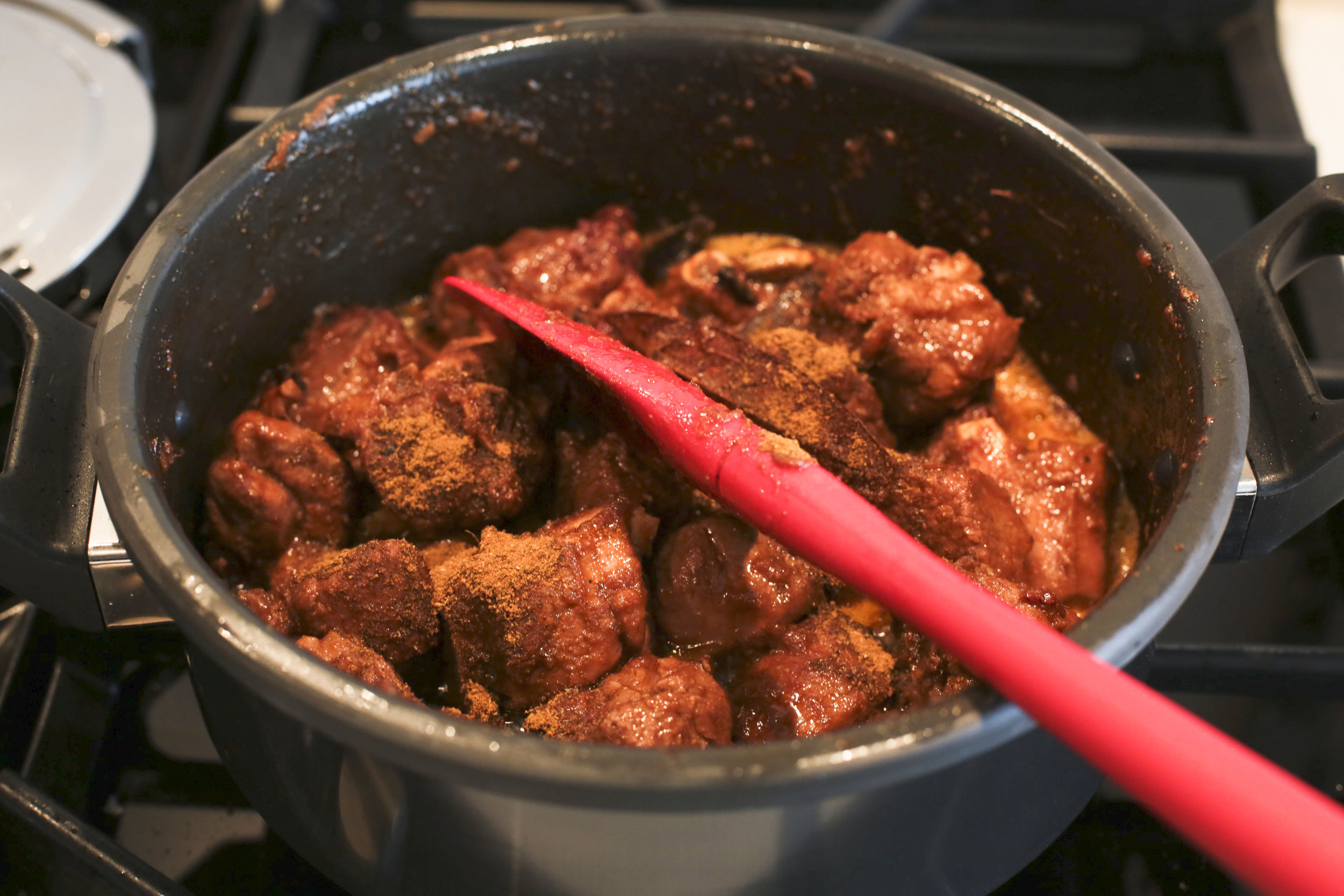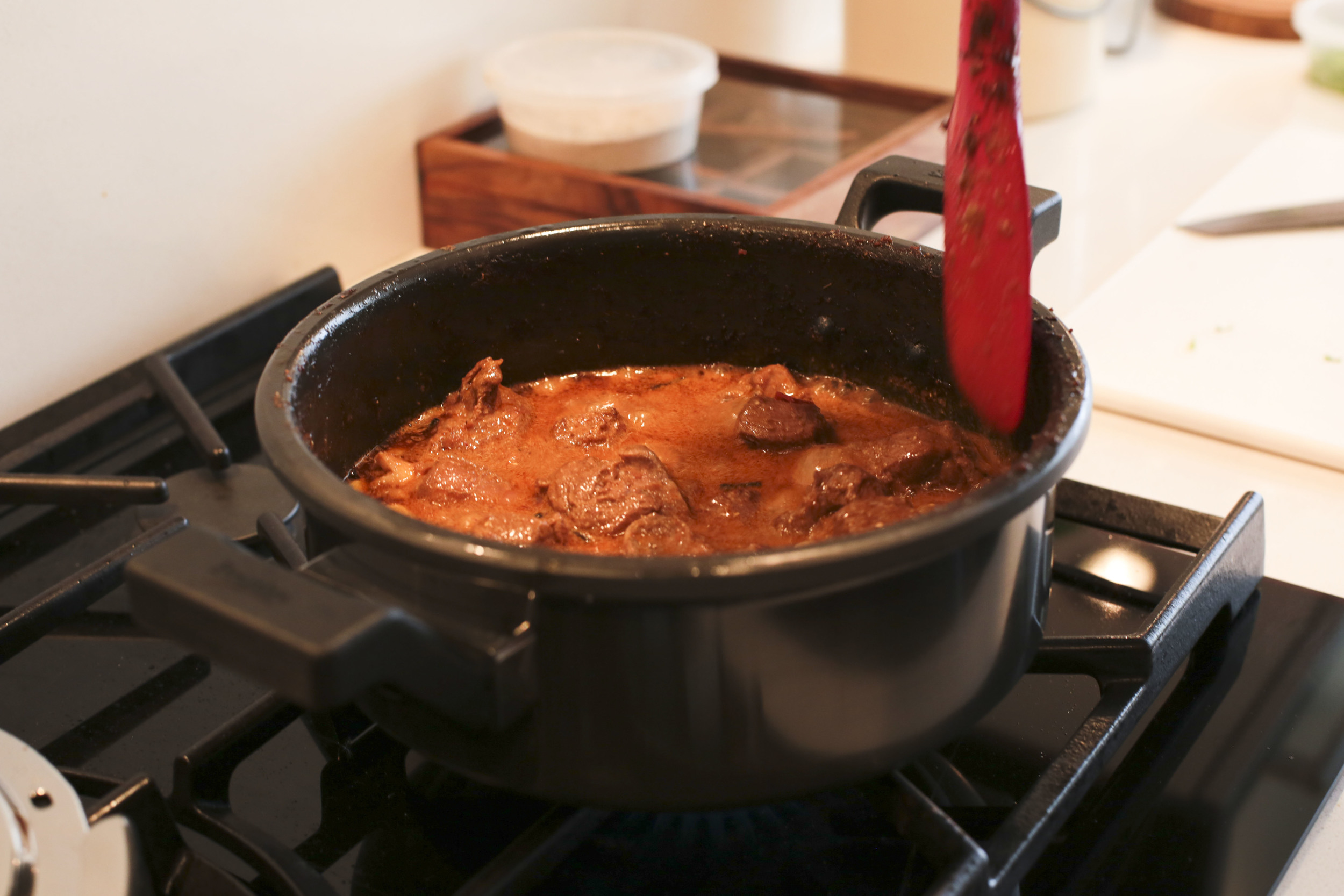At Home with Manu Chandra

#1000Kitchens is a series that takes you into kitchens all over the country, documenting heirloom recipes that tell a story. In this instalment, we visit Chef Manu Chandra at his home in Bangalore. The chef-restauranteur now runs eight restaurants across the country including the iconic Monkey Bar and Fatty Bao. He has been listed as one of the Fifty Most Influential Young Indians for two years in a row by GQ Magazine.
Manu Chandra pulls a bowl of mutton out from his fridge. His kitchen is a reflection of himself – quiet, meditative and entirely inscrutable. But scratch the surface, and there are surprises at every turn. Functional and beautiful, his Poggenpohl kitchen is fitted with Gaggenau (“The Ferrari of kitchen appliances”), a magnetic strip holding a Misono and an engraved knife (“Manu Chandra, 9-5-03”), and a drawer full of peelers (“You can never have enough of these”). An array of spices sit on the chimney, out of reach for most, but comfortable enough for the tall chef to effortlessly access his chilli oil and Paul Prudhomme seasonings. A bright yellow KitchenAid kettle and a muted blue cast-iron teapot add spots of colour in a chic black and white kitchen. Today he is cooking a slow, pan-roasted mutton curry.
"My grandmother was an orphan," he tells us. Chandraji's Mutton Curry is her recipe. “She was born in Lucknow and married my grandfather, an Urdu scholar and professor of criminology, and eventually moved to Delhi with him. But Lucknow influenced her cooking: frugal with onions, ginger and garlic, and gravies that are typically jhols (or watery). This commercialisation of thick gravy is what I call the Butter-Chicken Syndrome,” he says, straight-faced.
“I was raised by my grandparents. I watched her cook this many times; Dad cooked this one too. When people would come over, we’d have three or four kilos of meat in the pan, and I'd usually be the one standing by the stove, stirring constantly. He'd come by every now and then to check how it was doing."
In his own kitchen, Manu Chandra the Chef is clearly visible: he obsessively cleans as he goes, offering systematic insight into the choice of ingredient and technique employed. "You can add salt in the beginning, if you like," he warns, "but it leaches out all the moisture. And what we want here is a slow caramelisation."
“Lean meat works best,” he says as he patiently pan-roasts plump pieces of mutton in the fanciest pressure cooker we’ve ever seen – it could easily be mistaken for a Dutch oven, but what gives it away is the little whistle fitted to the lid. As the meat turns a deep golden and the aromas in the kitchen turn mellow, he spoons out a generous portion of creamy poppy seed paste into the pot. “I don't know why poppy seeds are disappearing. They have a such a lovely flavour.” He pulls out a chopping board and fresh coriander, demonstrating some wicked knife skills.
The mutton takes its time to cook, and we take a break to explore his living room. There's a careful design sensibility that defines his space. A crowded bookshelf, a sleek breakfast-counter and plenty of art: two pigs and an ape in a Botticelli-style orgy, and a shimmering canvas that packs sardines with glassy eyes and open mouths. “What do you like to read, Chef?” we ask, eyeing the towering bookshelf where The Flavour Bible and Ottolenghi’s Plenty share shelf space with Suzanne Collins' Hunger Games. “Nothing related to cooking,” he responds.
Back in the kitchen, he leans over and fans the spiralling aromas toward him. "The Smell Check," he says, glancing over, "is important and effective. The esters break against your fingers and help you gauge how the flavours are coming together.” He fastens a lid on the pot and leads us to a rooftop garden. "Now, we wait."
An hour or so later, as he unscrews the lid, a delicious aroma fills the room. It carries a homely familiarity. He tells us this is its most redeeming quality – that it will taste of home, no matter where in India you come from. He pulls out a set of bowls, and spoons the gravy over a bed of rice. We dig in eagerly, whole spices lending a homemade comfort to the dish.
We step into the terrace for a spot of fresh air. It’s one of those cold-but-sunny Bangalore days, and you can hear birds not so far away. A lush screen of tall, leafy plants affords privacy and solitude. You’d never imagine you were in the heart of the city. "I set up the garden months before the house was finished, so it would be ready when I moved in."
Do you grow herbs, or vegetables for your kitchen? “Nothing related to cooking,” he says, with a wry smile.
Recipe - Chandraji's mutton curry
Ingredients
1 kilo mutton, preferably lean meat in curry cuts
2 medium onions, finely chopped
2 tbsp fresh and thick yogurt, preferably homemade
1 tsp coriander powder
½ tsp cumin
1 tsp chilli powder
4 tbsp ginger garlic paste (or 4 cloves of garlic and 1 inch of ginger)
1 heaped tsp poppy seed paste
1 tsp garam masala
1.5 drops of kewda or screw-pine essence
Small bunch of cilantro, finely chopped
Vegetable oil
Salt to taste
Whole spices
3 black cardamom - split
5 green cardamom
4-5 cloves and
2-3 pieces mace
2 stick of cinnamon
1 tsp whole black pepper
5 bay leaves
2-3 pieces all spice (cubeb or tailed pepper will also do)
2 dried red chillies
Gravy base
Combine the yogurt with 2 cups of water, and blend thoroughly.
Method
Heat oil in a heavy-bottomed pan.
Add in the whole spices and onions.
Caramelize the onions till they turn golden brown, on a low flame. Add a dash of water, if needed, to reduce the temperature and prevent scorching.
Once nicely brown, add in the meat.
Continue pan-roasting, stirring continuously until the meat releases oil and turns a really dark colour. This takes at least 20 minutes, be patient.
At this point add in the coriander powder, cumin and chilli powder.
As the meat shrinks substantially, onions caramelize, and the oil is visible, add in the ginger-garlic paste.
Continue pan-roasting for another 10 minutes.
Add in the garam masala and a dash of water to bring it together.
Add in the yogurt now. Yogurt adds richness, mouth-feel, body and acidity to the dish. Pour slowly, while stirring continuously. Wait for it to simmer.
Now add half the coriander, save the other half for garnish.
Add in the poppy seed paste – this acts as a thickener, adding body and a lovely nutty flavour.
Now add two big pinches of salt – we don’t add salt earlier as it risks splitting the yogurt.
Add the kewda and a dash more water if you like your gravy more jhol.
Finally, bring the gravy to a boil, to make sure yogurt is completely stable.
Simmer for 40 minutes to an hour with a tight-fitting lid on top. Let it rest an hour or two after it is done, before eating.
Serve hot with rice.
**A previous version of this article mentioned The Twilight series instead of The Hunger Games. This has been corrected.
#1000Kitchens is a collaborative project between Goya Media and Alicia Souza.
Words by Anisha Rachel Oommen and photos by Aysha Tanya; Illustration by Alicia Souza of www.aliciasouza.com.
YOU MAY ALSO LIKE

























